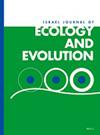三种不同繁殖策略水螅的移动性比较研究
IF 0.8
4区 环境科学与生态学
Q3 ECOLOGY
引用次数: 1
摘要
不育或孤立的栖息地可以显著减少与潜在交配伴侣的相遇次数,从而有利于进化和维持自我受精。对生殖方式和自交能力不同的亲缘物种进行迁移分析,可以支持被广泛接受但尚未得到明确验证的自交倾向于不育的理论。在这里,我们比较了三种不同生殖策略的水螅(刺胞目,水螅科)的移动性:能够自我受精的同时雌雄同体,顺序雌雄同体和性腺物种。结果表明,与顺序雌雄同体的普通水螅和雌雄同体的少水螅相比,具有自我受精能力的环切水螅的迁移能力(以个体穿越距离表示)显著降低。活动能力的差异与个体体型无关。栖息地隔离和有限的流动性很可能与…本文章由计算机程序翻译,如有差异,请以英文原文为准。
A comparative study of mobility in three Hydra species with different reproductive strategies
Sessility or isolated habitat can significantly reduce the number of encounters with potential mating partners and thus favour evolution and maintenance of self-fertilisation. Mobility analysis of phylogenetically related species that differs in reproductive mode and self-fertilisation ability could support the widely accepted but not clearly validated theory of selfing being favoured by sessility. Here, we compare mobility in three species of Hydra (Cnidaria, Hydridae) that differ in reproductive strategy: a simultaneous hermaphrodite able to self-fertilise, a sequential hermaphrodite, and a gonochoric species. The results indicate that mobility expressed as distance traversed by individuals is significantly reduced in Hydra circumcincta, a species that is able to self-fertilise, compared to sequential hermaphroditic Hydra vulgaris and gonochoric Hydra oligactis. Differences in mobility were not correlated to individual body size. It is likely that habitat isolation and limited mobility is associated wit...
求助全文
通过发布文献求助,成功后即可免费获取论文全文。
去求助
来源期刊

Israel Journal of Ecology & Evolution
环境科学-进化生物学
CiteScore
2.10
自引率
0.00%
发文量
7
审稿时长
>36 weeks
期刊介绍:
The Israel Journal of Ecology and Evolution includes high-quality original research and review papers that advance our knowledge and understanding of the function, diversity, abundance, distribution, and evolution of organisms. We give equal consideration to all submissions regardless of geography.
 求助内容:
求助内容: 应助结果提醒方式:
应助结果提醒方式:


